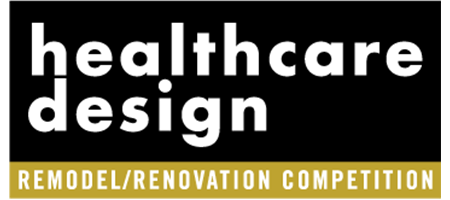Dayton Children’s Hospital Specialty Care Center, Dayton, Ohio
When Dayton Children’s Hospital began planning its strategic vision, Destination 2020, to revitalize its aging campus in 2013, its main focus was inpatient facilities. Yet five years later, when the new 130-bed patient tower opened in Dayton, Ohio, as the first piece of that master plan, outpatient services had grown even more than expected. As that volume tripled, the number of employed specialty physicians ballooned from 47 to 260, adding 12 new divisions including rheumatology and allergy while expanding others.
The pediatric hospital realized that this outpatient explosion required a dedicated growth strategy to consolidate specialty services sprawled across the main campus while accommodating future expansion. In 2018, the hospital re-engaged the design partners that collaborated on the master facilities plan and the construction of the patient tower—including Champlin/EOP Architects (Dayton) and CannonDesign (Dallas and Houston).
Together, they amended the master plan to incorporate a new outpatient building to optimize clinical efficiencies while paving the way for ongoing growth. “Outpatient specialty care has become a huge part of our business, and we needed the right facility for that space,” says Cindy Burger, a registered nurse and vice president and chief experience officer at Dayton Children’s Hospital.
The 152,000-square-foot Specialty Care Center, opened on Dayton Children’s main campus in 2023, provides collaborative spaces across five floors to support multidisciplinary care teams encompassing more than 30 specialties including ophthalmology, audiology, gastroenterology, and nephrology.
Leveraging standardized clinic modules, the design allows for flexibility and efficiency as patient volumes continue to fluctuate over time.
Maximizing clinic adjacencies
In selecting a site to relocate its specialty outpatient services, Dayton Children’s wanted to preserve access to the main hospital—both for patients and families who still need primary pediatric care and other services, and for staff and clinicians who need to move efficiently between buildings.
The organization also knew that parking was a major concern for parents, thanks to feedback from its parent advisory group. “We have a parking garage in front of the hospital, but families with strollers and wheelchairs wanted convenient surface parking for outpatient visits,” Burger says.
These two demands drove the location of the new facility behind the existing parking garage and adjacent to a new surface lot. (For more on the navigation strategy, go here.) Direct access to the main hospital is provided via pedestrian bridges, including a public bridge that connects patients and families to the first floor of the hospital and a second-floor bridge that links specialty physicians to the hospital’s surgical suite.
Facilitating flexibility in clinic design
Previously, Dayton Children’s specialty clinics were spread throughout the campus in rooms that “were specifically designed for and dedicated to those clinics, so there wasn’t any flexibility,” explains David Glover, principal at Champlin/EOP Architects. As patient volumes fluctuated day-to-day, some clinics ran out of space while rooms in other departments sat empty.
A primary goal for the expansion project was to create more flexibility to accommodate these changes. “We wanted to design spaces so that if a clinic needs eight exam rooms on Monday, but only six on Tuesday, and a year from now they might need 10, we would be able to flex,” Burger says.
To achieve this versatility, the design team developed standardized clinic pods—each consisting of an area for weights and measures, a procedure room, and centralized onstage/offstage nurses’ stations and support spaces surrounded by exam rooms.
“Each exam room is set up on a module of 120 square feet, and if the space needs to be larger, it’s in increments of those dimensions,” explains Mary Butler, associate vice president and healthcare planner at CannonDesign. “It gives [Dayton Children’s] the ability to take down a wall in the future to easily convert a space. We wanted it to be as flexible as possible for future growth and meeting the day-to-day needs of patients.”
Each floor generally contains three clinic pods as well as a designated area for diagnostics and testing. The pods are arranged so that “the clinics are all open to each other, which helps enhance the flexibility so the support spaces can be shared, and the boundaries of the clinics can flex,” says Lauren Downie, architect and medical planner at CannonDesign.
“It was a math game of knowing the volumes and translating that to the number of exam rooms,” Downie says. “For instance, a subspecialty may not have enough volume to fill an entire clinic pod, so locating that with a neighbor that may also need only a partial pod made for an efficient floor plate.”
Plus, shelled space on the fifth floor will accommodate other specialties scheduled to move into the new facility over the next 12 to 18 months, Burger says.
Building to support staff collaboration
Another key to the Specialty Care Center was creating space for collaboration. Realizing that some patients with complex conditions might see several specialists during one visit, the project team didn’t want families to have to travel across the building to receive comprehensive care.
“We started looking at the different specialties to see where the synergies lie and where patients may be seeing multiple specialists,” Downie says. “Co-locating these clinics gives patients a seamless and efficient experience.”
For example, a child visiting the cleft palate clinic might meet with a neurologist, plastic surgeon, and ear, nose, and throat physician during a typical visit, so it made sense to arrange these departments in proximity. The design also incorporates larger multidisciplinary rooms where care teams can gather with the patient. “It improves efficiency for everyone, and it improves the experience for patients,” Burger says.
Although the facility provides room for collaboration, one of the biggest changes was separating private offices from clinical spaces to maximize efficiency. Offices are located across the second-floor pedestrian bridge in the main hospital, centralized between outpatient services and inpatient surgery.
“We didn’t want to have any faculty office space embedded in the clinical footprint of this project to maximize the efficiency of the floor plan,” Butler explains.
Early post-occupancy evaluations have confirmed the efficiency of this design. “The overall square footage per exam room is very low compared to peer institutions and similar buildings,” Downie says. “Part of that is due to not having any offices within the building, plus the standardized layout also helped maximize how they utilize the space.”
Interior design to support branding
Dayton Children’s underwent a complete rebrand during construction of the inpatient tower, introducing a colorful logo and graphics to embody the revitalized patient experience. Through that process, the organization launched an arts and aesthetics committee—chaired by Burger with involvement from the CEO, chief strategy and marketing officer, graphic artists, and Champlin /EOP Architects.
This team continued to meet during the design of the new outpatient center, meticulously selecting every piece of fabric, artwork, and graphic element to ensure brand consistency.
The organization’s whimsical brand refresh embraces the theme of flight, inspired by the aviation innovation of the Wright Brothers, who hailed from Dayton. This playful concept guided the design aesthetic for the new outpatient facility, which features things that fly—from birds and butterflies to paper airplanes and rockets—using colors from the brand’s “whirligig” logo.
For example, the Specialty Care Center uses flight icons and brand colors to designate each floor in the building to assist with wayfinding. Orange owls mark the first floor, blue paper airplanes on the second, green birds on the third, and purple butterflies on the fourth. On each floor, the dedicated color and icon are integrated into accents on the floors, walls, artwork, furniture, and signage.
“It’s not overly in your-face, but each color and theme carries throughout the entire clinical space,” Butler says. “It’s almost like a game for kids to try to find the butterflies, so it’s an element of playful curiosity as well as wayfinding.”
This playfulness extends to the exterior of the building, using the same reflective metal panels featured at the main hospital. As the light shifts, these panels appear to change colors from lime green to navy blue throughout the day. “There’s a little bit of whimsy as you drive by, and all of our buildings look like they belong together,” Burger says.
Positioned for the future care
Together, the cohesive branded design and flexible modular planning create a welcoming environment that positions Dayton Children’s Specialty Care Center for contemporary pediatric care.
“This building will take us into the future,” Burger says. “We want our community to feel like we’re giving them the most up-to-date care that we possibly can, and this facility is certainly a big part of that.”
Brooke Bilyj is a freelance writer and owner of Bantamedia (Cleveland) and can be reached at [email protected].
Dayton Children’s Hospital Specialty Care Center project details
Location: Dayton, Ohio
Completion date: February 2023
Owner: Dayton Children’s Hospital
Total building area: 152,000 sq. ft.
Total construction cost: Est. $78 million
Cost/sq. ft.: $513
Architect: CannonDesign, Champlin/EOP Architects
Interior designer: Champlin/EOP Architects
General contractor: Danis Construction
Engineer: Heapy Engineering
Builder: Danis Construction
Art consultant: Distinctive Art Source
Project details are provided by the design team and not vetted by Healthcare Design.












